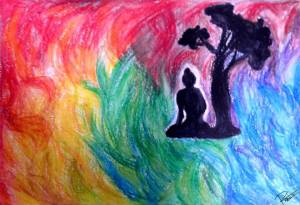(originally published at http://rotarypeacechula.wordpress.com/2013/07/03/colours-words-peace/)
The battle of power, politics and pride that we see
Is but a mirror of the war between I and me…
As I started pondering about this blog and formulating thoughts, words deserted me for a while. Colours invaded, instead. Before long, the fingers that fumbled over the keyboard were gingerly handling water-soluble oil-pastels, a medium that I am not used to painting in. And a blog emerged in this form:
My stint here, so far, as a Rotary Peace Fellow at the Chulalongkorn University in Bangkok, has reinforced a few questions that have perhaps been the drivers of my choices thus far in life. Much as I’d prefer answers to pave the way, it is often questions that make us tread the paths that we do, in the process, revealing us to ourselves.
So, the painting has multi-coloured flames surrounding the Buddha – the enlightened one. I chose fire as the element for various reasons. At a mundane level, fire is associated with violence and destruction. From a historical perspective, it stimulates growth by enabling cooking, industry, etc. From a spiritual standpoint, it is often referred to as the cleanser – that which purifies energies. It symbolises light and power. In summation, it seems to encompass all associations from the very negative to the very positive. Hence the varied hues of the flames.
And then there is the Buddha under the Bodhi tree (the tree of enlightenment). He is represented in black, the colour that absorbs every other, be it the passionately violent red or the serenely tranquil blue. The tree symbolises the concept of the Buddha as an entity like you and me, rooted to the Earth, standing firm against the vicissitudes of time, responding to the seasons, making every effort to bloom and bear fruit, and of course, provide the comforting shade of compassion and love. The enlightened one is not in denial of the raging red or passionate pink or the flaming yellow, nor of the luxuriant green or the calming blue or the alluring violet. No need or emotion or desire is good or bad. It simply is. Absorbing all of it into the non-judgmental black was the Buddha’s pathway to peace: absolute acceptance of self and therefore, of the world around. Often, blessings across the world have something to do with ‘being in the light’. In the Buddha’s case, the light is within.
The painting was my mind’s response to thoughts on peace amidst conflict. I choose, at this point, to deal with it at the level of the individual. I have no idea how to govern a country, let alone aim at world peace. Nevertheless, I do believe the macrocosm mirrors the microcosm, and hence the power of one is infinite.
So, what causes conflict within us as individuals? Ironically, often the very first lesson we are taught is a huge blow for the peace within. We are taught not to accept ourselves. As a girl child, I was told by parents trying hard to be liberal, “You are like my son.” The message I got was that it was not good enough to be a girl, one had to be ‘like a son’ to be of any value. School teachers often try to encourage us by comparing us to all and sundry who are better than us at something or the other, telling us we are not ok as we are. The competition in the university systems and the job market keep reinforcing our ‘areas of improvement’. In a world, whose systems we have willfully created, that continually screams non-acceptance at us, how are we to respond, but with inner conflict?
We try to mask this inner conflict by judging others as being not acceptable – the colour of his skin is too dark, she has conservative beliefs, he is too selfish, she is too career-oriented – all of this, to simply battle all that we do not accept in self, in some form or the other. If it were a quality that we accepted in ourselves, seeing it in others would not make us react, for then we would understand. It is only when we do not acknowledge and/or accept something in self, that we react to those things in others. Irritation is our mind calling attention to unaccepted aspects of self.
We find peace as individuals when we accept ourselves and celebrate us for who we are. Acceptance is not passivity. It is empowering. It is the first step to change and growth. Denial stalls change, for we do not admit the need for growth. Peace is a conscious choice.
My wish-list for world peace is simple: if only we held babies tight against our chests, regardless of their sex; if only we appreciated children for their efforts at learning, regardless of their grades; if only we hugged those that care, regardless of their economic class; if only we were grateful for love, regardless of who it came from; if only we shared in trust, regardless of who returns the trust and in what form; if only we respected the Mother Earth, who holds us to her bosom regardless of what we have been doing to her… we will know peace, in that moment.
In the meanwhile, our hope is the harbinger of peace. The flowers that bloom every spring, the bird that builds a nest after every storm, the naked street children that wear a big smile without knowing where their next meal will come from, the mothers that give birth in refugee camps – all remind us that peace is the destination of a conflicted world, and therefore, we must hope.
I am reminded of the words of the renowned Hindi poet Harivanshrai Bacchhan: “Need ka nirmaan fir-fir, neh ka ahvaan fir-fir…” Yet again one builds a nest, yet again there’s the call of love…

No comments:
Post a Comment